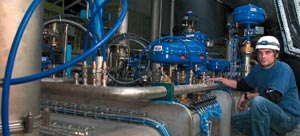The cryogenic system for the Large Hadron Collider (LHC) at CERN reached a major milestone on 7 April by achieving operation of the unit at Point 8 at its nominal temperature of 1.8 K. The LHC and its superconducting magnets are designed to operate at this very low temperature, making the 27 km accelerator the coldest large-scale installation in the world. Although acceptance tests performed on the surface had already reached the required temperature in 2002, this is the first time that the nominal temperature has been achieved in situ.

The LHC cryogenics system is hugely complex, with 31 kt of material (compressor stations, cold boxes with expansion turbines and heat exchangers, and interconnecting lines) requiring 700 kl of liquid helium passing through 40,000 pipe junctions.
Although normal liquid helium at 4.5 K would be able to cool the magnets so that they became superconducting, the LHC will use superfluid helium at the lower temperature of 1.8 K. Superfluid helium has unusually efficient heat-transfer properties, allowing kilowatts of refrigeration to be transported over more than 1 km with a temperature drop of less than 0.1 K.
Eight cryogenic installations distributed around the LHC ring, with a total power exceeding 140 kW, will cool the helium in two stages, first to 4.5 K and then to the final 1.8 K. Four units built by the Japanese-Swiss consortium IHI-Linde have already been installed; the other four units, made by the French company Air Liquide, are currently being installed and will be tested in 2006.








